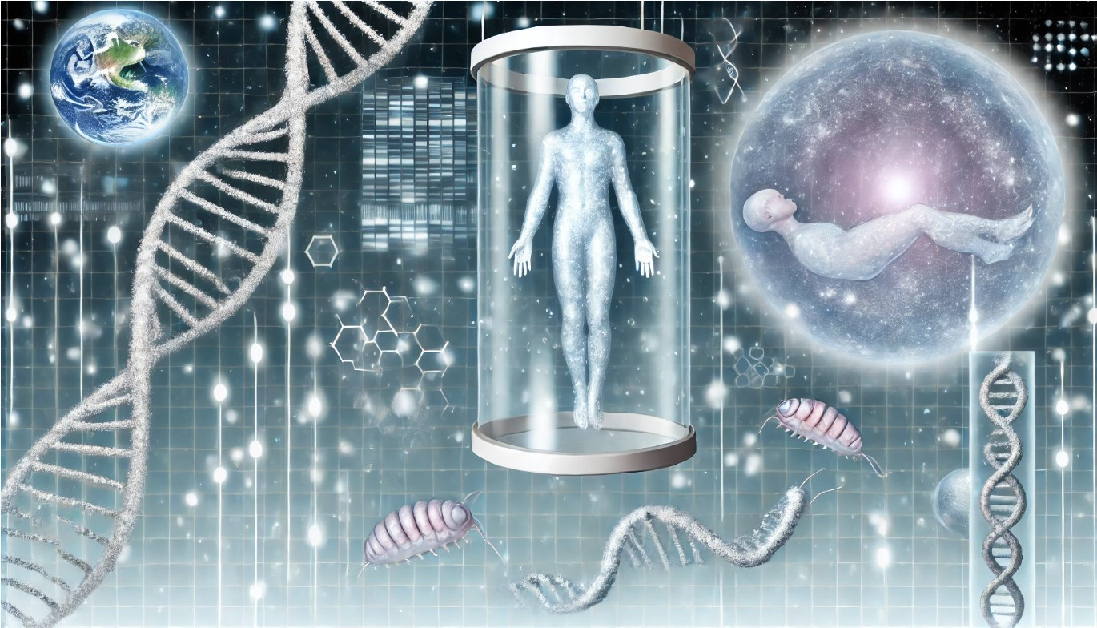Cryptobiosis is a fascinating biological phenomenon where certain organisms enter a state of extreme dormancy, suspending nearly all metabolic activities to survive the harshest of environments. Organisms like tardigrades, nematodes, and brine shrimp have mastered this survival mechanism, allowing them to withstand extreme conditions such as dehydration, freezing, oxygen deprivation, and even exposure to space. But could humans one day achieve such a state?
Hi. Most people live in the same place, sometimes in the same hose, all their Lifes. People, there is world out there!
What Is Cryptobiosis?
Cryptobiosis is the suspension of biological activity in response to extreme environmental stress. During this state, the organism’s metabolism slows to an almost undetectable level, allowing it to endure otherwise lethal conditions. When environmental conditions improve, the organism can “wake up” and resume normal function. This process is well documented in organisms like:
Tardigrades (water bears), which can survive the vacuum of space.
Nematodes (roundworms), which use cryptobiosis to survive extreme dehydration.
Brine shrimp, whose eggs can remain dormant for years in dry conditions.
The Human Potential for Cryptobiosis
The idea of humans entering cryptobiosis is an exciting but distant scientific possibility. To even consider such a state, several critical challenges in human biology must be addressed:

1. Metabolic Suppression
Humans depend on continuous metabolism for cellular function, energy production, and repair. To enter cryptobiosis, we would need the ability to suspend nearly all metabolic processes without causing cellular death. This includes halting oxygen and nutrient use while preventing damage to cell membranes, proteins, and DNA.
2. Cellular Dehydration and Protection
Organisms like tardigrades can replace water in their cells with protective molecules, creating a vitrified, “glassy” state that prevents cellular damage during freezing or desiccation. Humans would need a similar mechanism to avoid tissue damage from ice crystal formation or dehydration.
3. Temperature Tolerance
Cryptobiotic organisms can survive extreme cold and heat, conditions that human bodies cannot currently tolerate. Advances in biotechnology or cryoprotective molecules would be needed to help human tissues endure extreme temperatures without suffering irreversible damage.
4. Repair and Regeneration Mechanisms
After a prolonged state of dormancy, organisms in cryptobiosis rely on repair mechanisms to fix any cellular damage. Humans would require similar capabilities, potentially enhanced through stem cell activation or advanced tissue regeneration technologies, to recover from metabolic suspension.
5. Controlled Resuscitation
One of the greatest challenges would be safely reintroducing metabolism after a cryptobiotic state. Human organs, tissues, and biological systems must be carefully managed to prevent shock or failure as normal metabolic processes restart.
6. Biotechnological Enhancements
Genetic engineering, synthetic biology, or nanotechnology could provide humans with traits observed in cryptobiotic organisms. For instance, expressing proteins that protect DNA and cellular structures from damage could be a step toward inducing cryptobiosis in humans.
7. Insights from Cryonics and Suspended Animation
Current research in cryonics and suspended animation offers a glimpse into potential methods of metabolic suspension. While these techniques slow down biological processes to preserve life for medical purposes or space travel, they are far from achieving the level of cryptobiosis seen in nature.
The Future: What Could Cryptobiosis Offer Humans?
If humans could enter a cryptobiotic state, the potential applications would be groundbreaking:
Space Travel: Long-duration space missions could become feasible, as humans in cryptobiosis would not require food, oxygen, or environmental control for extended periods.
Medical Advances: Patients with severe trauma or life-threatening conditions could be placed in cryptobiosis, allowing them to survive until appropriate treatments become available.
Challenges and Ethical Considerations
While the concept of human cryptobiosis is captivating, it raises numerous ethical and biological questions:
Ethical Concerns: Should humans even attempt to enter cryptobiosis? The implications for life extension, space travel, and medical preservation would need to be carefully considered.
Biological Complexity: Humans have highly complex organs and systems that may not respond well to complete metabolic suspension, meaning extensive research would be needed to avoid catastrophic damage.
Final Thoughts: Can We Solve the Puzzle?
Dr. Walter Rivera Santos, a Ph.D. research student from Puerto Rico, is exploring the possibilities of human cryptobiosis, seeking to unlock the secrets of how life can be paused and restarted without damage. His work represents the future of this thrilling field, one that could change how we think about survival, life extension, and even space exploration.
Cryptobiosis may still be a distant reality for humans, but as science progresses, we continue to push the boundaries of what life can endure. Perhaps one day, humans will join tardigrades in the ranks of nature’s greatest survivors.
Stay tuned to FilmRx.VIP for the latest in cutting-edge scientific exploration and discoveries.
